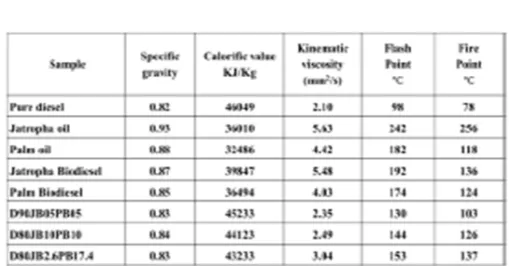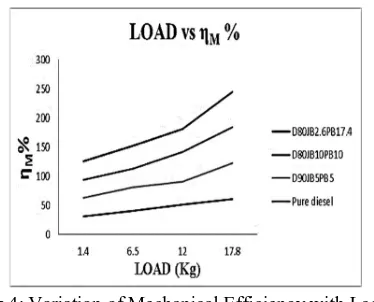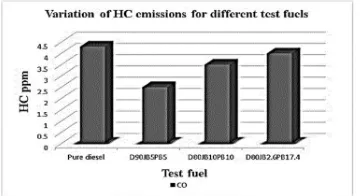Experimental Evaluation of Performance and
Emissions of Dual-Blended Bio-Diesels with Diesel
as an Alternative Fuel for Diesel Engines
Sk. Gouse Sharief
1, G. Jitendra
2, Sk. Ammaji
31, 2NRI Institute of technology, 3NRI college of pharmacy, (Affiliated to Jawaharlal Nehru Technological University Kakinada),
Pothavarappadu, Agiripalli (M), Vijayawada Rural, Krishna District, A.P, India
Abstract: We know that year to year the emission standards are becoming stringent due to the air pollution caused by the usage of fossil fuels. It is difficult for the developing countries like India to meet such stringent emission standards as it involves expensive technologies. Previous researches shows that Biodiesel fuelled diesel engines emit less C0, HC and smoke emissions than diesel fuelled engines. In this paper, a dual biodiesel blend, mixture of two different kinds of biodiesel namely “palm biodiesel” (Elaeis guineensis) and “jatropha biodiesel” (Jatropha curcas) in diesel is considered for evaluation in a single cylinder direct injection diesel engine with varying loads after going through physical properties analysis. The objective of present work is to investigate experimentally the effects of Dual Biodiesel blends on performance and emissions of diesel engine under various loads at constant speed.
I. INTRODUCTION
Environmental concerns have increased regarding vehicular pollution and also import of fuel is increasing due to high demand for the fuel year to year. Many governments have neglected this issue which has been significantly contributing to climate change and economy. The Research works carried out in this area focus on improving efficiencies and limiting emission levels. Biodiesel reportedly offers a good solution to the above- mentioned problems due to its similar properties to conventional diesel. The engine power output and the fuel consumption of the vegetable oil and its blends are almost the same when the engine is fuelled with diesel. Due to lower calorific values and higher viscosity as compared to diesel, vegetable oils are converted to biodiesel.
Previous research works found out that high kinematic viscosity and density fuels with lower calorific value tend to increase the BSFC and lower the brake power as it results in poor atomization of fuel during spraying of fuels inside the combustion cylinder. The presence of high amount of oxygen molecules in biodiesel results in complete combustion of fuel. This condition leads to lower hydrocarbons and carbon monoxide emissions. The other uses of biodiesel include its use as heating fuel in boiler furnaces, as a fuel in electricity generators to produce electricity, as a lubrication additive, as a fuel in transport industry including marine industry etc. Also it promotes agriculture as it is produced from plants and animal fats.
II. LITERATURE REVIEW
A. K. Srithar
The 2 biodiesels pongamia pinnata oil and mustard oil were prepared by transesterification process. The dual biodiesel blends were prepared in different proportions like D90PPB5M5, D80PPB10M10, D60PPB20M20, D40PPB30M30, D20PPB40M40 and D0PPB50M50. From the experimental analysis results, the thermal efficiency and mechanical efficiency of blends were very closer to the diesel values. The specific fuel consumption values of dual biodiesel blends were comparable to diesel. Blends produced slightly lower CO and CO2 than diesel.
B. B. Deepanraj
Tests were carried out using 10, 20, 30, 40 and 50% palm biodiesel blends. The biodiesel blends produced lower CO and unburned HC emission than neat diesel fuel due to the availability of oxygen content and produced higher NOx than diesel because of the higher temperature inside the combustion chamber. Biodiesel blends produced lower brake thermal efficiency & higher specific fuel consumption than diesel because of the low calorific value & produced higher exhaust gas temperature than neat diesel.
C. Deepak Agarwala
oils posed operational and durability problems when subjected to long-term usage in CI engine. These problems are attributed to high viscosity, low volatility and polyunsaturated character of vegetable oils. The performance and emission parameters for different fuel blends were found to be very close to diesel. 20% LOME blend was found to be the optimum concentration, which improved the thermal efficiency of the engine, reduced the smoke density and BSFC.
D. Y.D. Wang
The vegetable oil biodiesel blends were prepared in different proportions like 25%, 50%, 75%&100%. The engine power output and the fuel consumption of the engine are almost the same when the engine is fuelled with vegetable oil and its blends compared with that of pure diesel. The emission of nitrogen oxides from vegetable oil and its blends are lower than that of pure diesel.
E. F.K. Forson
Diesel fuel, jatropha oil, and blends of diesel and jatropha oil in proportions of 97.4% / 2.6%; 80% / 20% and 50% / 50% by volume are tested on the diesel engine. The test showed an increase in brake thermal efficiency, brake power and reduction of specific fuel consumption for jatropha oil and its blends with diesel. The conclusion from the study is that the 97.4% diesel / 2.6% jatropha fuel blend produced maximum values of the brake power and brake thermal efficiency as well as minimum values of the specific fuel consumption and suggested to be used as ignition-accelerator additive for diesel fuel.
F. Rupesh Gupta
Biodiesel blends of soya bean oil was used and tested in a VCR type 4-stroke diesel engine. 05% SBD – 95% diesel (B5) and 10% SBD – 90% diesel (B10) in volume and the effect of B15, B20 blends were noticed on brake thermal efficiency and exhaust emission products of the test engine. Biodiesel blends have substantially up to 20% give less CO emission without affecting Brake Thermal Efficiency (BTH) of the engine. B20 blends show the minimum NOx emissions and HC emissions.
III. PRODUCTION OF BIODIESEL
A. Transesterification Process
The conversion of straight vegetable oils into biodiesel by the process called transesterification to overcome the usual problems encountered by using straight vegetable oils. Transesterification is the process of treating triglycerides such as vegetable oils with alcohol in the presence of a catalyst to produce glycerol and fatty acids ester.The transesterification is the method of biodiesel production from oils and fats and can be carried out by two ways.
1) Catalytic Transesterification.
a) Homogeneous acid catalysed transesterification.
b) Homogeneous alkaline catalysed transesterification.
c) Heterogeneous catalysed transesterification
d) Lipase catalysed transesterification
e) Nano catalysed transesterification.
f) Transesterification using ionic liquids as catalysts. 2) Supercritical Methanol transesterification.
a) Technique Used: Heterogeneous catalysed transesterification. The use of homogeneous catalysts, especially base catalysts, is associated with some amount of difficulty in purification of by-product glycerol as well as in the requirement of wastewater treatment. To eliminate all these problems, the use of heterogeneous catalysts usually solid base catalyst is recommended. Solid base catalysts have many advantages, such as having mild reaction condition, easy separation, and high activity and less contaminant. Many researchers argued that the use of heterogeneous catalysts both in acid and base form brought about the advantage of having easy and less costly separation as well as possibility of reusing the catalyst.
B. Steps Involved In Production Of Biodiesel Through Transesterification Process 1) Heating of raw oil up to 60℃.
2) Preparation of methoxy solution.
3) Mixture of heated oil and methoxy solution.
4) Stirring of mixture (30 min).
C. Palm Biodiesel
D. Jatropha Biodiesel
IV. PRODUCTION OF BIODIESEL BLENDS
A. Nomenclature
D(x) JB(y) PB(z)
D(x) = x% of diesel in 100% blend.
JB(y) = y% of jatropha diesel in 100% blend. PB(z) = z% of palm diesel in 100% blend.
1) Preparation of D90JB5PB5 Blend: It is prepared by taking out 100 ml diesel from I litre of diesel and replaced with 50 ml jatropha and 50 ml palm biodiesel. D90JB5PB5 = 90% of Diesel + 5% of Jatropha Biodiesel + 5% of Palm Biodiesel.
2) Preparation of D80JB10PB10 Blend: It is prepared by taking out 200 ml diesel from 1 litre of diesel and replaced with 100 ml jatropha and 100 ml of palm biodiesel. D80JB10PB10 = 80% of Diesel + 10% of Jatropha Biodiesel +10% of Palm Biodiesel.
3) Preparation of D80JB2.6PB17.4 Blend: It is prepared by taking out 200 ml diesel from 1 litre of diesel and replaced with 26 ml jatropha and 174 ml of palm biodiesel. D80JB10PB10 = 80% of Diesel + 2.6% of Jatropha Biodiesel +17.4% of Palm Biodiesel.
B. Measurement of fuel Properties 1) Flash point.
2) Fire point.
3) Specific gravity.
4) Calorific value.
[image:3.595.170.429.601.734.2]5) Viscosity.
V. EXPERIMENTAL SETUP AND EXPERIMENTATION
The engine used is a water cooled single cylinder vertical diesel engine is coupled to a rope pulley brake arrangement to absorb the power produced necessary weights and spring balances are induced to apply load on the brake drum suitable cooling water arrangement for the brake drum is provided. Separate cooling water lines are provided for measuring temperature. A fuel measuring system consists of a fuel tank mounted on a stand, burette and a three way cock. Air consumption is measured by using a mild steel tank which is fitted with an orifice and a U-tube water manometer that measures the pressures inside the tank. Also digital temperature indicator with selector switch for temperature measurement and a digital rpm indicator for speed measurement are provided on the panel board. A governor is provided to maintain the constant speed. For measuring the emissions the gas analyser is connected to the exhaust flow.
A. Specifications of VCR Diesel Engine 1) Company = Kirloskar
2) Type of cooling = Water cooled
3) Engine cc = 990 cc
4) Engine power = 6 KW (approx.)
5) Cylinder Bore (d) = 102 mm
6) Stroke Length (L) = 116 mm
7) Compression Ratio (CR) = (13.2 – 21.5)
B. Emission Measurement Setup
Gas analyser is mainly used to know the emissions. Gas analyser measures the concentration of CO C02, and 02 in volume
percentages and the concentration of HC in parts per million (ppm). The system uses a non-dispersive infrared system for determining the concentration CO, C02, and HC, and performs the measurement of 02 by electrochemical cells.
VI. RESULTS AND DISCUSSION
A. Performance Analysis
1) Brake Thermal Efficiency: Fig shows the variation of BTHE with Load. Thermal efficiency indicates how well an energy conversion or transfer process is accomplished from the graph it was found that, Brake Thermal Efficiency is maximum for D90JB5PB5 biodiesel blend and it is minimum for D80JB10PB10. The increase in thermal Efficiency D90JB5PB5 is due to a complete combustion of fuel. The decrease in thermal efficiency D80JB10PB10 is due to lower calorific value and higher viscosity. At full load Brake thermal efficiency for the test fuels pure diesel, D90JB5PB5, D80JB10PB10 and D80JB2.6PB17.4 are 18.37%, 18.58%, 14.61 and 17.28%.
Fig 1: Variation of BTHE with Load
Fig 2: Variation of BSFC with Load.
3) Brake Power: The output power of an engine is known as brake power. Fig shows the variation in brake power of the tested biodiesel samples with varying loads. D90JB5PB5 sample showed slight increase in brake power of average 1.5% than diesel Apart from that pure diesel dominated the output brake power at various loads. The viscosity and density plays major roles in atomization process of fuels and can slow down the fuel-air mixing rate, which can result in poor combustion of fuels leading to a lower brake power.
Fig 3: Variation of BP with Load.
[image:5.595.205.392.518.669.2]4) Mechanical Efficiency: Fig shows the variation of Mechanical Efficiency with Load. Mechanical efficiency is defined as the ratio of brake power (BP) to indicated power (IP) of an engine. From these observations plot it is observed that the various blends like D90JB5PB5 and D80JB2.6PB17.4 exhibits slightly increase in mechanical efficiency at full load conditions than diesel fuel. But considerable improvement in mechanical efficiency was observed by the blend D80JB10PB10 because of lowest frictional powers compared to diesel.
Fig 4: Variation of Mechanical Efficiency with Load.
Fig 5: Variation of Volumetric Efficiency with Load.
B. Emissions Analysis
1) CO Emissions: Incomplete combustion of fuels results in formation of carbon monoxide. Petroleum fuels do not contain any oxygen molecule in their chain and readily produces carbon monoxide. Since, biodiesel have oxygen in their structure, the combustion of biodiesel is more complete resulting in considerably lower carbon monoxide emissions than fossil diesel Graph shows variation of CO emissions for different test fuels. From the graph. It is evident that CO emissions gradually decreased for the samples D90JB5PB5 and when compared to pure diesel. Average reduction of 7.1% 17.7% and 7.1% was observed for D90JB5PB5, D80JB10PB10 and D80JB2.6PB17.4 samples respectively, when compared with diesel.
Fig 6: Variation of CO emissions for different test fuels.
2) C02 Emissions: Carbon dioxide is formed when there is sufficient amount of oxygen present during formation of CO as combustion product. The emissions are the result of complete combustion of fuel. In Fig D90JB5PB5, D80JB2.6PB17.4 and D80JBl0PB10 showed average 2.6% increase, 20.6% increase and 4.1% decrease respectively than diesel.
Fig 7: Variation of C02 emissions for different test fuels.
3) HC Emissions: Graph shows variation of HC emissions for different test fuels. HC Emissions for the blends D90JB5PB5, D80JBl0PB10 and D80JB2.6PB17.4 showed average of 15%, 5% and 3% decrease respectively when compared to diesel.
[image:6.595.213.393.635.733.2]
VII. CONCLUSION
A. Biodiesel samples made from mixing palm and jatropha biodiesel with conventional diesel at different proportions were examined for viscosity, density and calorific value and are much more comparable to diesel.
B. Lower blends of dual biodiesel samples up to 20% biodiesel have performed in par with diesel.
C. The sample D90JB5PB5 showed 1.5% average increase in brake power than those operated with conventional diesel.
D. The result shows that lower viscosity and greater calorific values of fuel leads to higher brake power and vice versa.
E. BSFC is lowest for pure diesel at all loads when compared to other three.
F. Higher viscosity resulting in poor mixing of biodiesel blend with air increases BSFC due to weak atomization of fuel.
G. Brake Thermal Efficiency is maximum for D90JB5PB5 biodiesel blend and it is minimum for D80JB10PB10. The increase in thermal efficiency D90JB5PB5 is due to a complete combustion of fuel. The decrease in thermal efficiency D80JB10PB10 is due to lower calorific value and higher viscosity.
H. For CO emission, reductions were estimated at 7.1%, 7.1%and 17.7% for D90JB5PB5, D80JB2.6PB17.4 & D80JB10PB10 samples respectively when compared to conventional diesel.
I. At the measurement of C02 emissions D90JB5PB5, D80JB2.6PB17.4 and D80JB10PB10 showed average 2.6% increase, 2.6%
increase and 4.1% decrease respectively than diesel.
J. Based on the findings of this research it can be concluded that lower blends of dual biodiesel blends D90JB5PB5and D80JB2.6PB17.4 can be used as alternative fuels in diesel engine without any engine modification.
REFERENCES
[1] K. Srithar, K. Arun Balasubramanian, V. Pavendan, B. Ashok Kumar, et al, 2017. “Experimental investigations on mixing of two biodiesels blended with diesel as alternative fuel for diesel engines”. Journal of King Saud University – Engineering Sciences 29, 50–56.
[2] Deepanraj B, Dhanesh C, Senthil R, et al, 2011. “Use of palm oil biodiesel blends as a fuel for compression ignition engine”. Am. J.Appl. Sci. 8, 1154–1158. [3] Deepak Agarwala, Lokesh Kumar b, Avinash Kumar Agarwal b, et al, 2008 “Performance evaluation of a vegetable oil fuelled compression ignition engine”.
Renewable Energy 33, 1147–1156.
[4] Y.D. Wang a, T. Al-Shemmeri, P. Eames, J. McMullan, N. Hewitt, Y. Huang a, S. Rezvani, et al, 2006. “An experimental investigation of the performance and gaseous exhaust emissions of a diesel engine using blends of a vegetable oil”. Applied Thermal Engineering 26 (2006), 1684–1691.
[5] Forson, F.K., Oduro, E.K., Hammond-Donkoh, E., et al, 2004. “Performance of jatropha oil blends in a diesel engine”. Renew. Energy 29, 1135–1145. [6] Rupesh Gupta, Param Gupta, Jatin Bhalla and Shubham Mourya, et al, 2016. “Performance Analysis of Diesel Engine using the Soybean Oil based Biodiesel”.
Indian Journal of Science and Technology vol 9 (36) 1-6.
AUTHOR DETAILS
Shaik. Gouse Sharief Ph. No: +91 7337312125
Email: gouseshaik834@gmail.com


